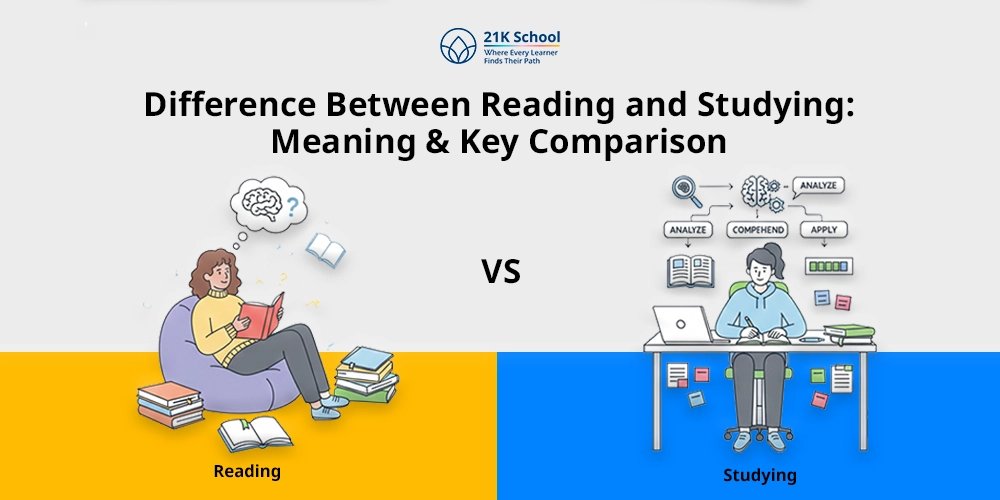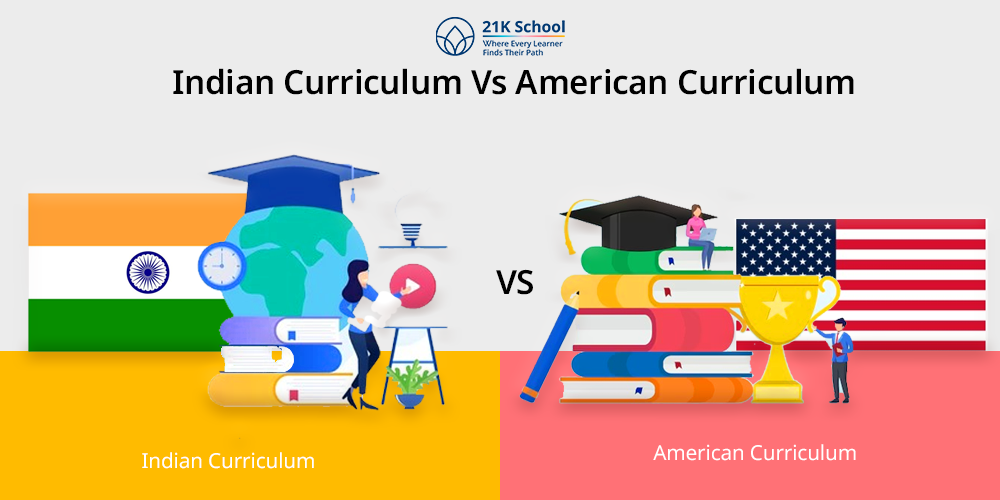
Do you know how the Indian curriculum is different from the American curriculum?
The Indian curriculum and the American curriculum are both approaches to an educational system.
The Indian curriculum is based on the Indian education system that follows the National Curriculum Framework (NCF) and abides by the National Education Policy (NEP) .
The American curriculum follows the US Education system, which follows a three-tier model known as Elementary school, Middle school, and Higher education.
The American curriculum provides a flexible and easy assessment method, which provides customisation of education. The Indian curriculum also focuses on a standardised curriculum that has an emphasis on a grading system based on theoretical knowledge.
High-quality education can significantly increase a student’s chances of success through creative thinking skills and problem-solving skills . Both curricula are adapted to the same assessment-based teaching and learning methods .
Contents
What is the Indian Curriculum?
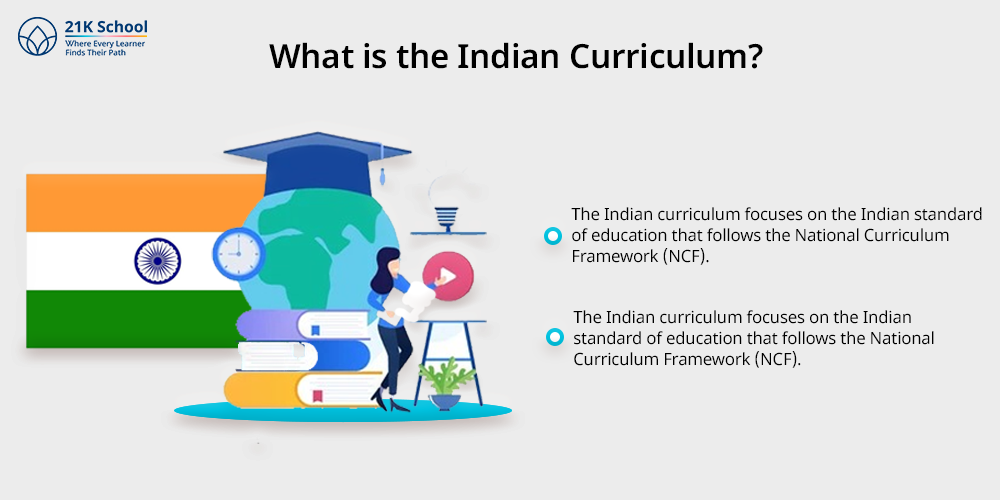
The Indian curriculum focuses on the Indian standard of education that follows the National Curriculum Framework (NCF). The Indian curriculum follows a standard learning system, which has an emphasis on structured learning.
The Indian curriculum aims at providing quality education across various subjects and disciplines. The Indian curriculum places a high value on academic achievement with tests and grades receiving special attention.
The Indian curriculum mostly focuses on traditional aspects of theoretical knowledge with an emphasis on the rote learning method. The structure of the Indian curriculum is divided into 3 stages known as Primary, Middle, and Higher Education.
The Indian curriculum focuses on the holistic development of students, which helps in enhancing problem-solving skills and developing collaboration skills among students.
What is the American Curriculum?
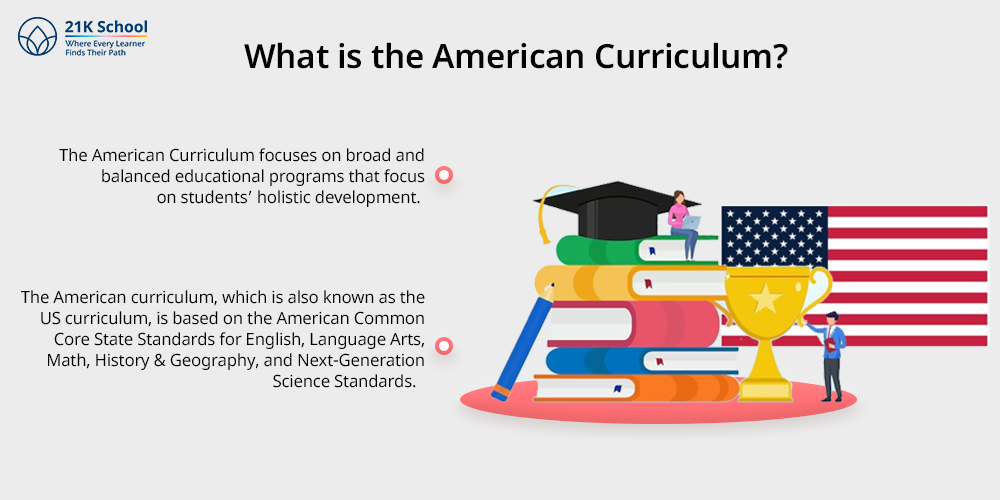
The American Curriculum focuses on broad and balanced educational programs that focus on students’ holistic development.
The American curriculum, which is also known as the US curriculum, is based on the American Common Core State Standards for English, Language Arts, Math, History & Geography, and Next-Generation Science Standards.
Along with the theoretical aspects, the American curriculum focuses on practical knowledge with a greater emphasis on extracurricular activities.
The curriculum of America focuses on developing all-round knowledge of students through practical exposure.
The subjects and programs designed by the American curriculum are to develop well rounded education that helps in developing holistic education .
In the American curriculum, students are assessed through exams, essays, and practical work, which helps in evaluating their performance.
8 Differences Between the Indian Curriculum and the American Curriculum
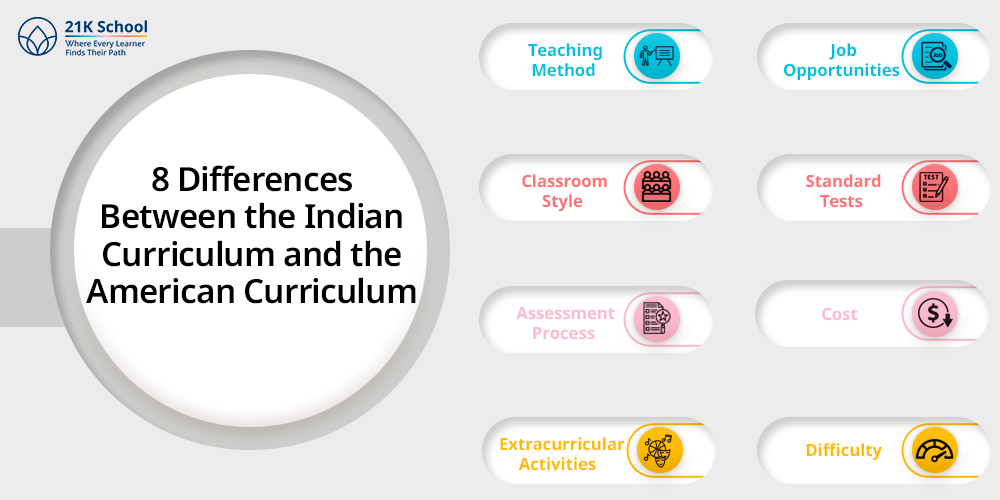
The Indian curriculum and the American curriculum are two distinct forms of educational structures. The Indian curriculum focuses on traditional aspects of theoretical knowledge with an emphasis on the grading system .
On the other hand, the American curriculum follows US Standards Education with a focus on extracurricular activities and students’ needs-based education, providing flexibility.
Both curriculum focuses on the holistic development of students, enabling them to learn diverse content. Here are the differences between the Indian curriculum and the American curriculum.
| Aspect | Indian Curriculum | American Curriculum |
| Teaching Method | The teaching method of the Indian curriculum mainly focuses on theoretical education with an emphasis on the rote learning method. | The teaching method of the American curriculum focuses on practical learning that makes learning impactful through discussions, projects and hands-on activities. |
| Classroom Style | The Indian classroom has a bigger class ratio, with an emphasis on teacher-centred learning. | The American classroom has a smaller class ratio, with an emphasis on student-centred learning. |
| Assessment Method | The assessment method of the Indian curriculum mostly focuses on standardised exams and oral, and practical exams. | The assessment method of the American curriculum focuses on Grade Point Average (GPA), which is evaluated through projects, quizzes, summative assessment and class participation. |
| Extracurricular Activities | The Indian curriculum mostly focuses on the traditional aspect of learning, with less focus on extracurricular activities | The American curriculum focuses on extracurricular activities like clubs, sports and the arts, which enhances students’ participation. |
| Career Opportunities | The Indian curriculum has an emphasis on a theoretical approach to education, due to which students have to face a competitive job market. | The American curriculum provides students with hands-on learning. Students who have achieved degrees from the American curriculum have a high chance of career opportunities. |
| Standardised Test | Students who follow the Indian curriculum mostly take standardised tests such as NEET, JEE, or GATE in order to gain admission to college | The American curriculum conducts standardised tests such as the SAT, GATE or ACT in order to provide admission to college. |
| Expensive | The Indian curriculum is considered as cost-effective, as compared to the American curriculum, because various government programs support free education. | The American curriculum is considered more expensive as compared to the Indian curriculum, especially in higher education. |
| Difficulty Level | The Indian curriculum is more challenging due to its rigorous examination format and emphasis on theoretical knowledge. | The American curriculum is not considered too difficult; however, some subjects and their contexts are difficult. |
1. Teaching Method
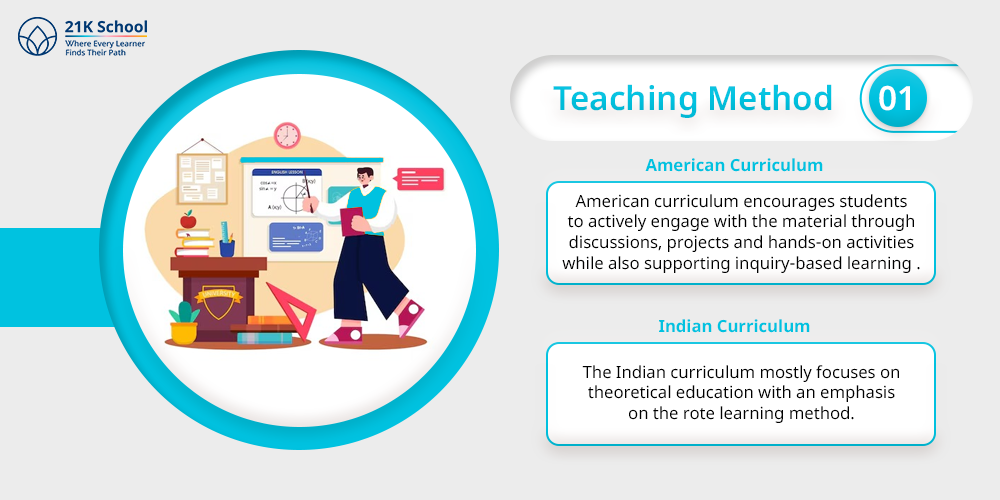
American Curriculum: The teaching method of the American curriculum encourages students to actively engage with the material through discussions, projects and hands-on activities while also supporting inquiry-based learning .
Indian Curriculum: The Indian curriculum mostly focuses on theoretical education with an emphasis on the rote learning method. In India, the teaching method was more focused on memorisation of concepts and information. However, with the new education policy, a focus was laid on experiential learning with a focus on practical knowledge.
2. Classroom Style
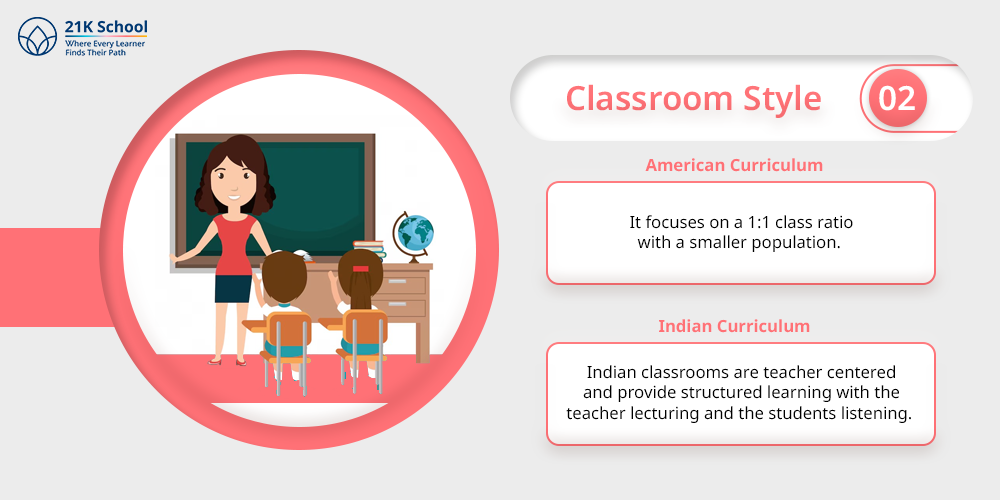
American Curriculum: The American classroom style focuses on a 1:1 class ratio with a smaller population. The American classes promote a collaborative learning environment in which students can study without any hindrances. The classroom of the American curriculum allows flexible learning opportunities where students can express their ideas.
Indian Curriculum: Indian classrooms are teacher centered and provide structured learning with the teacher lecturing and the students listening. The class sizes of the Indian schools are basically informal and have a huge population.
3. Assessment Process
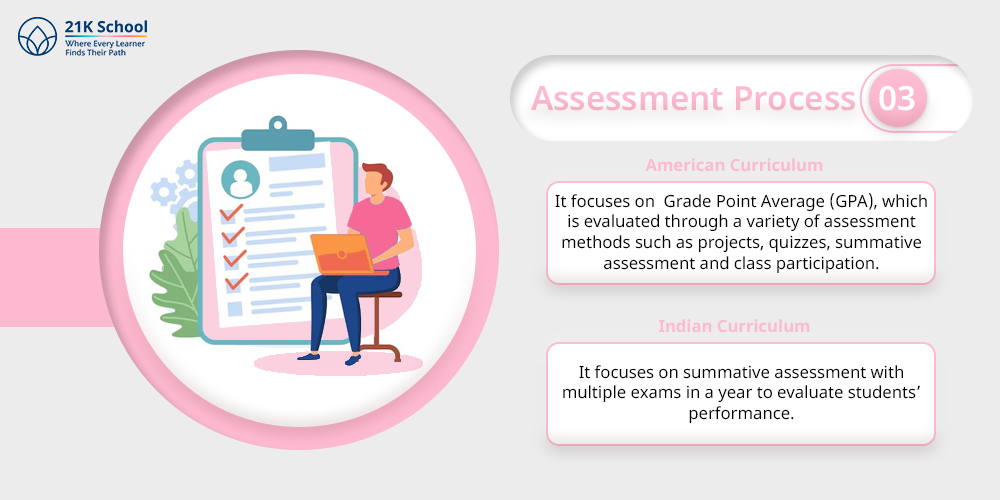
American Curriculum: The American Curriculum focuses on Grade Point Average (GPA), which is evaluated through a variety of assessment methods such as projects, quizzes, summative assessment and class participation. The American curriculum provides flexible assessment methods that enable it to meet its diverse needs.
Indian Curriculum: The Indian curriculum mostly focuses on standardised exams with an emphasis on traditional learning . The Indian curriculum mostly focuses on summative assessment with multiple exams in a year to evaluate students’ performance. However, students are also evaluated on the basis of practical and oral tests.
4. Extracurricular Activities
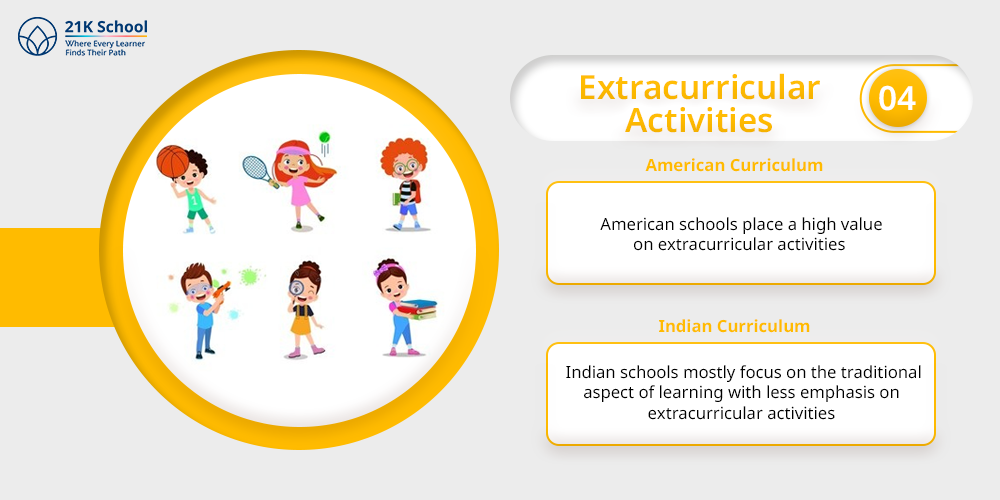
American Curriculum: American schools place a high value on extracurricular activities like clubs, sports and the arts because they believe that these pursuits are essential to students’ overall development.
Indian Curriculum: Indian schools mostly focus on the traditional aspect of learning with less emphasis on extracurricular activities. However, the NEP 2020 has also put an emphasis on extracurricular activities such as sports, games, as well as fun learning activities .
Explore the difference between extracurricular activities and co-curricular activities.
5. Job Opportunities

American Curriculum: Students who have passed through the American curriculum have a wider range of career opportunities. Students who have achieved degrees from the American curriculum have a broader range of job opportunities in MNCs. Students who have studied in the American curriculum are provided with internships and hands-on experience.
Indian Curriculum: The Indian curriculum mostly focuses on the theoretical approach of education, due to which students have to face a competitive job market. Due to a competitive job market with lower practical exposure, students find it difficult to get employment quickly. However, vocational education was also introduced by the government to provide students with practical skills and enhance their employability.
6. Standard Tests
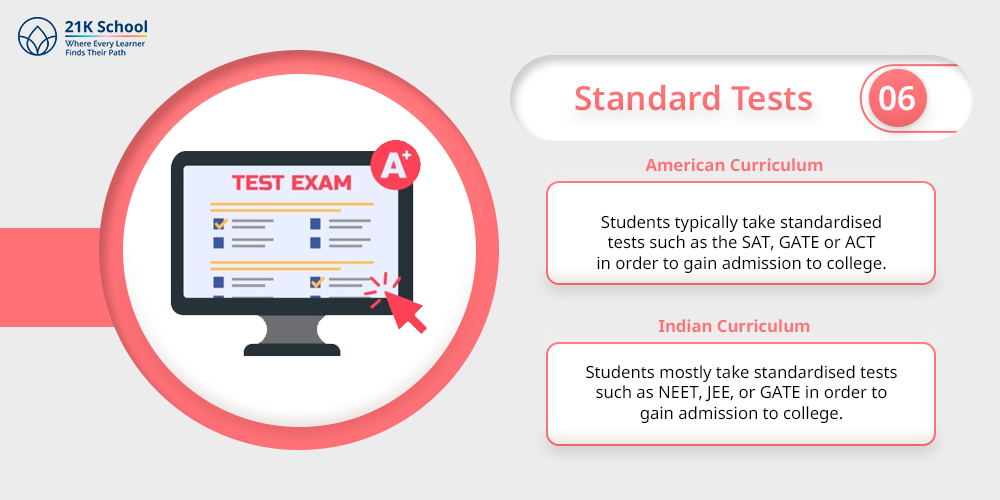
American Curriculum: Students with an American curriculum typically take standardised tests such as the SAT, GATE or ACT in order to gain admission to college. These assessments look at a range of skills and knowledge to evaluate students ability.
Indian Curriculum: Students with an Indian curriculum mostly take standardised tests such as NEET, JEE, or GATE in order to gain admission to college. These assessments are used to evaluate knowledge and students’ abilities.
7. Cost
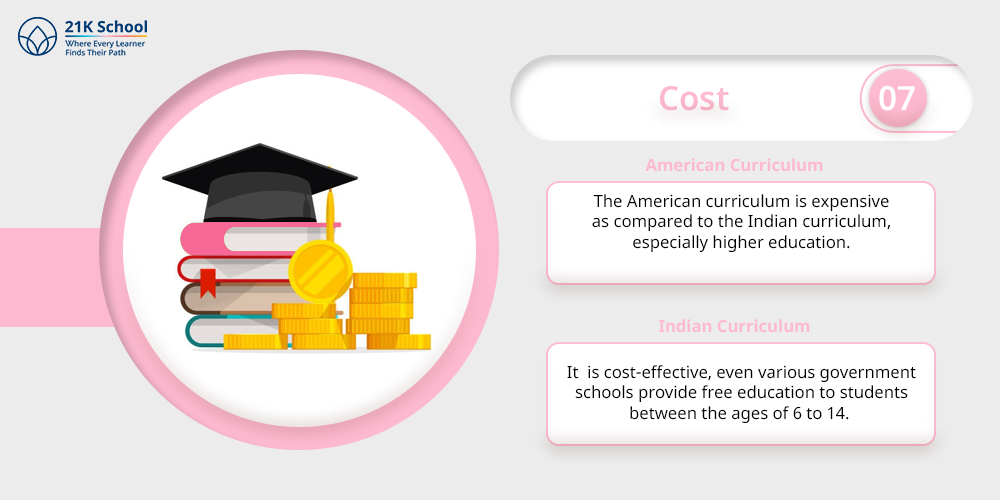
American Curriculum: The American curriculum is expensive as compared to the Indian curriculum, especially higher education. The cost of American education for both public and private institutions is extremely high. This causes many students to drop out of their courses.
Indian Curriculum: The Indian curriculum is cost-effective, even various government schools provide free education to students between the ages of 6 to 14. As compared to the American curriculum, various Indian private institutions are also less affordable.
8. Difficulty
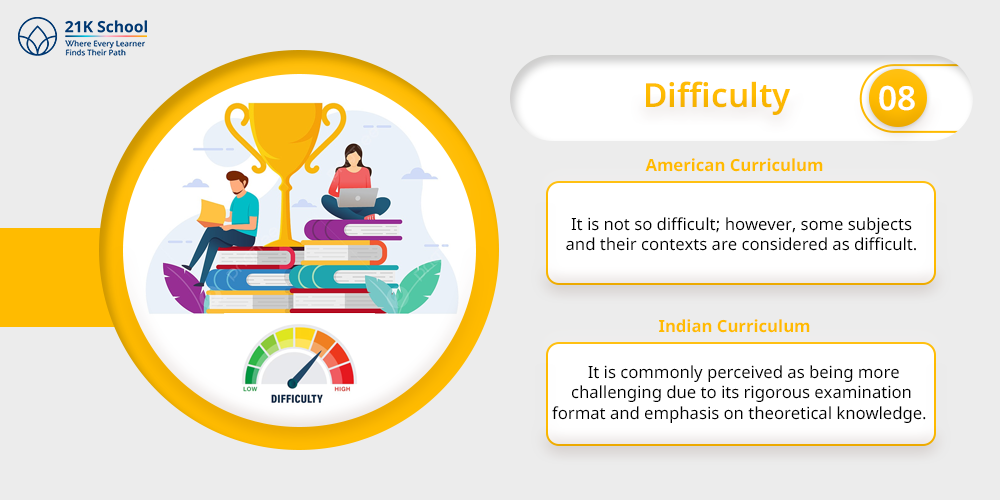
American Curriculum: The American curriculum is not so difficult; however, some subjects and their contexts are considered as difficult. The American curriculum provides flexibility, which allows students to study as per their own learning methods.
Indian Curriculum: The Indian educational system is commonly perceived as being more challenging due to its rigorous examination format and emphasis on theoretical knowledge. The Indian curriculum mostly focuses on standardised methods of memorisation and rote learning.
Read on to learn more about advantages of the Indian education system and also about problems in the education system of India.
Ending Note
The India and the American curriculum reflect two distinct educational philosophies and approaches.
The Indian curriculum focuses more on theoretical knowledge, rote learning and standardised assessments than the American curriculum, which promotes flexibility in practical learning and an all-encompassing approach to education.
Both systems aim to foster student development despite using different methods in the classroom and in the evaluation process.
Knowledge of these differences can aid educators and learners in making better decisions as globalisation continues to affect education, leading to improved learning outcomes and increased career opportunities.


